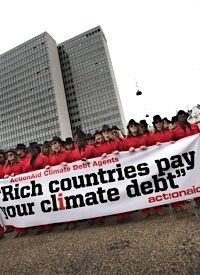
With the start of the UN Climate Change Conference in Copenhagen only two weeks away, pressure is increasing for industrialized world — and the United States, in particular — to submit to plans which would severely restrict industries (such as power plants) which emit carbon dioxide, while transferring wealth to Third World nations to encourage adoption of "green" technologies.
However, as it becomes increasingly clear that the political "spotlight" in the United States is presently focused on healthcare collectivization and not "cap-and-trade," a sudden flurry of advocacy is attempting to redirect attention on “climate change” before the opportunity to seize control of the global economy is squandered.
The recent scandal caused by the release of communications among scientists associated with the UN’s IPCC pushing "global warming"/"climate change" theories has further damaged the prospects for Copenhagen. The scientists in question were allegedly committed to suppressing scientific evidence that did not fit the theory — an apparent confirmation of what many "climate change" skeptics had figured was taking place.
Attempting to take back the momentum, the media is now filled with ‘doom and gloom’ stories about the threat of climate change. Thus, for example, a story (“U.N.: Greenhouse Gases Hit Record in 2008”) at CBSNews.com alarming reports on the rising level of carbon dioxide in the atmosphere:
Greenhouse gases in the Earth’s atmosphere reached record highs in 2008, with carbon dioxide levels increasing faster than previously, the U.N. weather agency said Monday.
Levels of greenhouse gases, believed to be responsible for global warming, have been rising every year since detailed records started being kept in 1998, the World Meteorological Organization said.
It follows a trend of rising emissions that began with the Industrial Revolution in the mid-18th century, the agency said.
The report by the World Meteorological Organization comes as the European Union urged the United States and China on Monday to set targets for cutting greenhouse gas emissions at next month’s climate conference in Copenhagen. The European Union said delays by those countries were hindering global efforts to curb climate change.
The gases — carbon dioxide, or CO2; nitrous oxide, N2O; and methane, CH4 — are produced partly by natural sources, such as wetlands, and partly by human activities such as fertilizer use or fuel combustion.
But the data on the relationship between carbon dioxide levels and global warming is by no means clear. One model has examined the available data to demonstrate that the rise in carbon dioxide may be caused by global warming, and not vice versa. And, although carbon dioxide levels are on the rise, it would appear that the relationship between greenhouses gases and global temperature is not conforming to the computer models employed by IPCC scientists. Thus, according to a report at Spiegel Online:
The planet’s temperature curve rose sharply for almost 30 years, as global temperatures increased by an average of 0.7 degrees Celsius (1.25 degrees Fahrenheit) from the 1970s to the late 1990s. "At present, however, the warming is taking a break," confirms meteorologist Mojib Latif of the Leibniz Institute of Marine Sciences in the northern German city of Kiel. Latif, one of Germany’s best-known climatologists, says that the temperature curve has reached a plateau. "There can be no argument about that," he says. "We have to face that fact." …
Climatologists use their computer models to draw temperature curves that continue well into the future. They predict that the average global temperature will increase by about three degrees Celsius (5.4 degrees Fahrenheit) by the end of the century, unless humanity manages to drastically reduce greenhouse gas emissions. However, no one really knows what exactly the world climate will look like in the not-so-distant future, that is, in 2015, 2030 or 2050.
This is because it is not just human influence but natural factors that affect the Earth’s climate. For instance, currents in the world’s oceans are subject to certain cycles, as is solar activity. Major volcanic eruptions can also curb rising temperatures in the medium term. The eruption of Mount Pinatubo in June 1991, for example, caused world temperatures to drop by an average of 0.5 degrees Celsius, thereby prolonging a cooler climate phase that had begun in the late 1980s.
Evidence regarding other “greenhouse” gases can be just as ambiguous. Even the EPA (relying on IPCC statistics) acknowledges that the U.S. contribution to man-made methane dropped by five percent between 1990 and 2007, and since 23 percent of the total man-made component of methane production is from “enteric fermentation” (that is, in the digestive tracts of humans and domesticated animals), reducing the levels of this greenhouse gas faces certain obvious limitations.
The complex interactions which control the global climate still remain beyond mankind’s ability to adequately quantify, let alone control. What is less difficult to calculate is the loss of quality of life which will result from the draconian controls that UN bureaucrats are planning to unleash on the industrialized world at the Copenhagen conference.
Photo: AP Images



